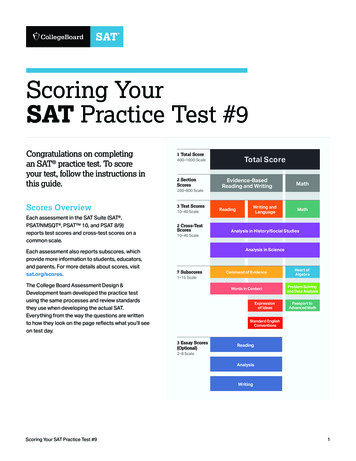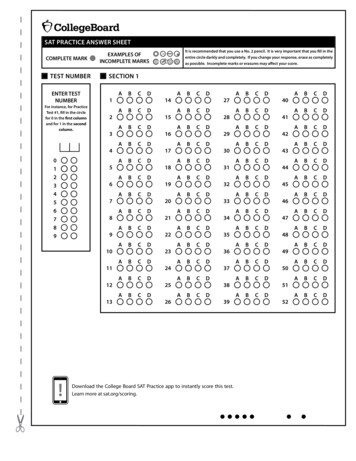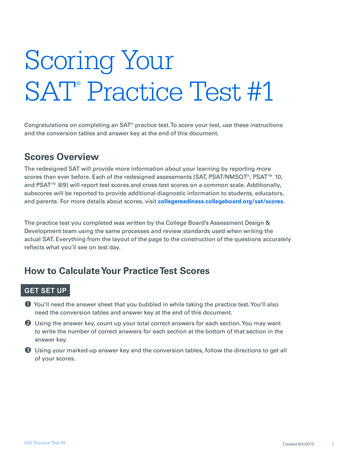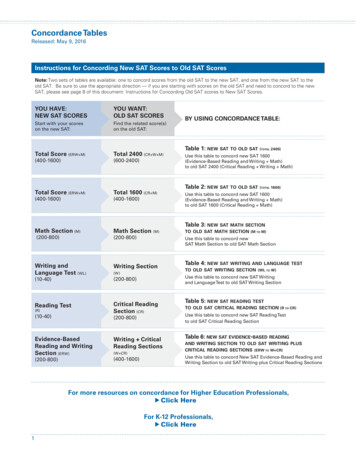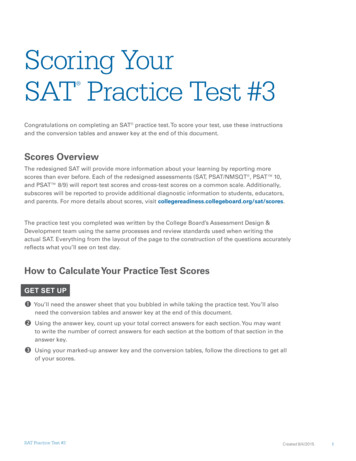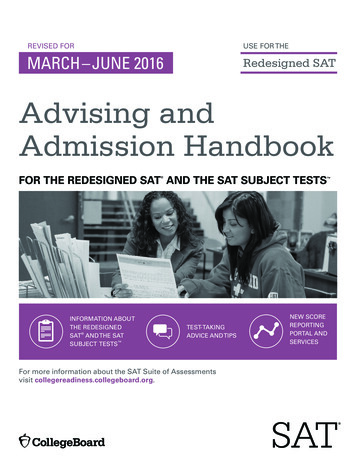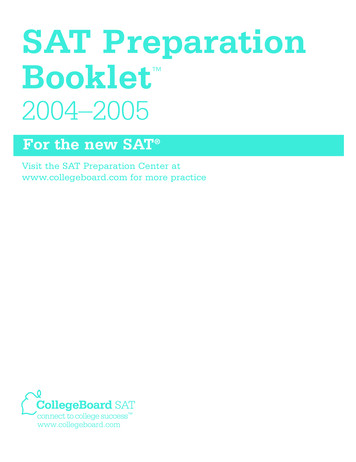
Transcription
New SAT ScoringAdvantageHow Much Better Can YouExpect to Do?By Laura Staffaroniwww.PrepScholar.com
TABLE OF CONTENTS:Intro.31: What’s Changed?.42: Old vs. New SAT Math .63: Old vs. New SAT Reading/Writing.94: How Does This Affect You?.135: And Now What?.15Copyright detotheoriginal.
INTRONew SAT Scoring AdvantageWhile the new SAT is out of 1600 and the old SAT isout of 2400, the two aren't directly proportional; you can'tjust multiply your old SAT score by 2/3 and expect theresult to be how you'd do on the new SAT.The only way to know for sure how you'd do on thenew test (besides taking the new SAT exam) is to use theCollege Board's data to convert your score from old to newSAT. To find out if you’d score higher on the new SAT andwhy that might be the case, read on!3
1: What’s Changed? Key Point: It’s now relatively easier to get a highnumerical score on the SAT; how much higherdepends on what you were scoring before.College Board premiered the new SAT March 2016, witha new out-of-1600 scoring system that now gives one outof-800 Math score and out-of-800 Reading score.The increased importance of Math to the overall SATscore isn’t all that’s changed, however; the difficulty of theindividual sections appears to have shifted as well.4
1: What’s Changed?Based on data released by the College Board, a 700 onthe old SAT Math isn’t the same as a 700 on the new SATMath section. Similarly, a 700 on the old SAT Reading and700 on SAT Writing isn't the same as a 700 on the new SATEvidence-Based Reading and Writing section.Even after adjusting for the 1600/2400 change, it’seasier to get a higher score on the new SAT than itwas on the old SAT, especially if you had an averagescore. The amount by which you’d score higher varies withyour scoring range.5
2: Old vs. New SAT MathThe comparison for this section is pretty straightforward:based on the concordance tables released this spring by theCollege Board, there’s an average 29 point increase on thenew SAT Math section compared to scores on the oldversion.This average does not take into account number ofpeople who score at each score point, however; you can’texpect score 30 points better no matter what your old SATscore was. The graph on the next page sheds a little morelight on the matter.6
302010OldSATMathScores7
2: Old vs. New SAT MathHere's an example of how the score differencebetween the old and new SAT Math sections works out: Ifyou got a 730/800 on the old SAT Math section(shown as a black vertical bar in the graph on the previouspage) and took the new SAT with exactly the samepreparation and skills, you’d likely score a 760/800. If youscored around the national average of 510 on the oldSAT Math section, you'd similarly expect to see a newSAT Math score of 540.Except for those scoring at the Conclusion:very extremes of the range, most students canexpect to see at least a 20 point increase fromtheir old SAT Math scores on the new SAT Mathsection.8
3: Old vs. New SAT Reading/Writing Key Point: Harder to compare because of changefrom 1600 to 800 score range; still, new SAT scoreson these sections are relatively higher.Comparing old SAT Reading & Writing and new SATReading and Writing is a little trickier because Reading andWriting have been smushed into one score on the new SAT(Evidence-Based Reading and Writing, or EBRW).The College Board has kindly provided concordancecharts to help out with this calculation. The charts show thatyou can still expect to see higher scores on the new SAT9
3: Old vs. New SAT Reading/WritingEBRW compared to the old SAT Reading and Writingsection scores.If the two tests were exactly equivalent, you’d expectthat the combined old Reading and Writing section scores(a range of 400-1600) divided by two would be the same asthe concorded new SAT Evidence-Based Reading andWriting score (a range of 200-800). This, however, is notthe case.Instead, students can expect to score between zeroand sixty points better on EBRW than they would haveon each of the Critical Reading and Writing sectionson the old SAT. The graph on the next page gives a moredetailed look at how the score increases are distributedacross old SAT combined Reading and Writing scores.10
2015601600ScoreIncreaseonNewSATEvidence- ‐BasedReadingandWri ng(200- ‐800)OldSATCri calReading Wri ngvs.NewSATEBRW70605040302010OldSATCri calReading Wri ngScores(400- ‐1600)11
3: Old vs. New SAT Reading/WritingTo put this graph in context, consider the followingexamples. If you took the old SAT, got Critical Reading700 and Writing 710 (a combined score of 1410, shownas a black vertical bar in the graph on the previous page),and took the new SAT with exactly the same preparationand skills, you could expect to score a 740/800 onEvidence-Based Reading and Writing. If you gotaround the national average old SAT scores of 500 onReading and 480 on Writing, you could expect to scorea 550 on Evidence-Based Reading and Writing - a hugejump.Most students who take the new Conclusion:SAT can expect to score relatively higher on theEvidence-Based Reading and Writing section,compared to old combined Reading and Writingscores.12
4: How Does This Affect You?Point: Take the new SAT if your old SAT score Keyindicates you could get a 20 point increase persection. Higher numerical scores make a better firstimpression on those considering your application.Theoretically, schools have access to the concordancetools needed to compare old and new SAT scores andadmissions officers will do their due diligence to understandthat it’s easier to get higher scores on the new SAT. Schoolswon’t be superscoring between the old and new SAT,so it’s not like you can get a 760 Math on the new SAT andcombine that with your Critical Reading and Writing scoresfrom the old SAT for a higher superscore.13
4: How Does This Affect You?In practice, however, a SAT result of 510 Math/650 Evidence-Based Reading and Writing makes abetter impression than 470 Math/590 Reading/590Writing (even though according to the College Board’sconcordance tables and its conversion tool, these scores areequivalent). Even after the old SAT has been phased outentirely from college applications, it will take admissionsofficers a little while to adjust and align their unconscious,split-second assessments of student scores with the newreality that more students will be getting higher scores onthe SAT, and so a 760 isn't as impressive as it used to be.Therefore, if you took the old SAT and scored in arange where you can expect to see at least a 20-pointincrease in nominal score, you should consider takingthe new SAT to see if you can get a higher score. Addeffective prep to that score increase, and you might verywell be able to get a high enough score on the new SAT tostep yourself over the threshold for acceptance for collegespreviously just out of reach.14
AND NOW WHAT?Through this guide, you’ve learned a lot about how muchyou can expect to see your score increase from the old tonew SAT. Make sure you consider your specific situationand weigh the costs and benefits of taking the new test toget the best score results.We at PrepScholar believe we’ve built the best SAT prepprogram in the world. But even if you don’t work with us atPrepScholar, we hope you found this guide useful.Next up: Read our free Ebook on the PrepScholarsystem today: Click here to get your Ebook!or call us at 1(866) 811-5546, where one of ourAcademic Advisers will walk you through the best optionsfor you and your family.We’d love to hear from you.Finally, if you found this guide helpful, please share it withany other people who might benefit.Good luck!-The PrepScholar Team
New SAT Scoring Advantage While the new SAT is out of 1600 and the old SAT is out of 2400, the two aren't directly proportional; you can't just multiply your old SAT score by 2/3 and expect the result to be how you'd do on the new SAT. The only way to know for sure how you'd do on the new test (beside
